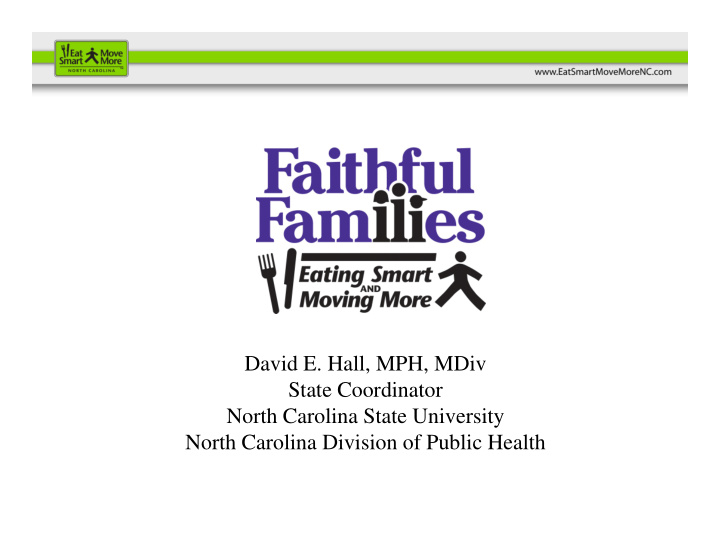



David E. Hall, MPH, MDiv State Coordinator North Carolina State University North Carolina Division of Public Health
• Over 60 partner organizations • Where you Live, Learn, Earn, Play, and Pray
Why work with Faith Communities • Holistic focus • Community organization • Connection to personal faith • Educate to change policy and enforce policy
Why work with Faith Communities • Family Focus • Accountability • Never heard sermon on gluttony or sloth
Faith Programs & Tools African American Churches Eating Smart and Moving More Who is it for? How do you get it? How is it used? Church staff and Complete a guide Provides guidance and members, health request form which can tools for nutrition and department staff, be downloaded from physical activity Cooperative the Eat Smart, Move programs in African- Extension Agents and More NC website or American churches. community partners. attend a training. African American Churches Eating Smart and Moving More - Planning and Resource Guide assists churches with planning, promoting and implementing programs for health and wellness.
Faithful Families Eating Smart and Moving More Resource Guide • Who is it for? • How do you get it? • How is it used?
Available on the Website
Faithful Families Eating Smart and Moving More Resource Guide • Surveys • Sample Policies • Promotion material • Sample Program Plan
Resource Guide Uses • Consider new practices or policies that could promote health of members • Look at campus or grounds of faith community– how can it be used to promote health • How can faith community Eat Smart and Move More?
Resource Guide Uses • Learn from others • Consider starting a health ministry in the faith community • Assess current ways health is promoted in the faith community
Faithful Families Project • Focus on two counties per year • Goal to reach at least Ten faith communities in each county • At least one policy and one environmental change per community related to eating smart and/or moving more
Faithful Families Project • Nine sessions offered to each faith community • One person hired for Faithful Families project in each district • In each county one year • Connect faith community with other county resources
Origin of Faithful Families • Creation of Advisory Board • Staff present with Faith and Health Experience • Curriculum development • Focus on county partners
Based on Multi-level Model The model takes into consideration: • the complex nature of the church community and • provides a framework for intervening at multiple levels of influence on health behaviors and practices.
CDC Recommendation • Priority should be given to interventions that move beyond increasing individual awareness and provide the environmental and policy changes that support behavior change, particularly among those with the greatest need.
Kate B. Reynolds Charitable Trust • Mission: To improve the quality of life and quality of health for the financially needy of North Carolina • Partners with many organizations in the state focusing on Prevention of Obesity and Disease
Which Faith Communities to Target • Tied to funding • Low income related to mission of Kate B. Reynolds Trust • Must adapt for faith community – Everyone welcome • How about your situation?
Project guidelines • Work with faith leader to select two lay leaders to co-teach the curriculum • Lay leaders provided training to lead classes, recruit members, etc
Role of Faith Leader • If faith leader is on board • If faith leader is not as active a player in the health ministry
Is Something Going On? • Don’t assume there is not a health ministry in place • Do ask what the purpose of that committee is?
How to begin the relationship? • Look for partners who have faith community connections • Communicate timeline for action • Expect long-term commitment • Refer, Refer, Refer
Successes and Lessons Learned • Many policies in place/ subcommittee in Local Physical Activity and Nutrition Coalition • Recruitment is work • Our timeline is not binding on others • Lay leaders need communication and encouragement
Change will come • Individual changes • Change in Faith Community as a Whole – Determine how decisions are made – Communicate change: make sure people know – Make sure changes sustainable
Keep the Fires Burning • Check in with faith community partners • Provide education in group setting with other faith communities.
Next Steps • State-wide dream • New delivery method coming soon • Will depend on local county staff to expand project
What questions do you have?
Thank you David_hall@ncsu.edu
Recommend
More recommend